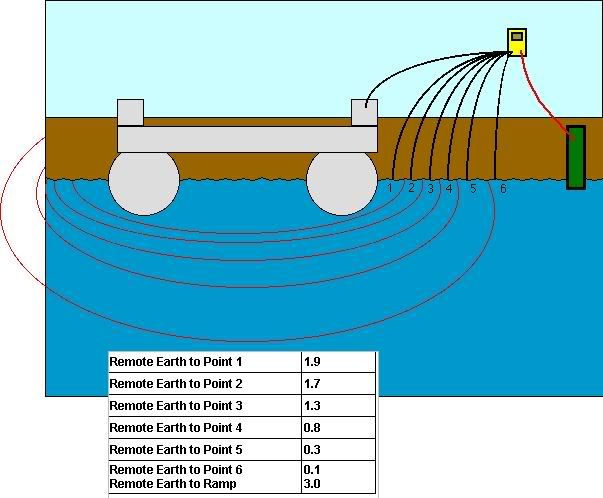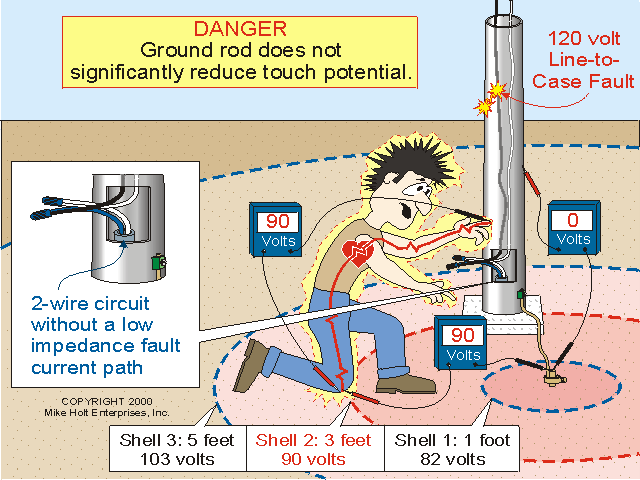georgestolz said:
Here is a
revised doodle.
But the voltage doesn't disappear when the service disconnect is off.
Edit to add: (My point is, I believe he has isolated the problem only to the neutral on the line side of the service disconnecting means. It could conceivably be an inch or a mile from that point. It could be on the line side of the POCO transformer; I don't see how we could be more specific than that the info at hand. That's my only point on this.)
(Lou has corrected us, there is no sub-panel at the marina, but I'm only mentioning that to clarify, not to hound you.)
If he were to drive a ground rod at the shore nearest the pier, and connect the ramp to that, I would consider it a band-aid to the problem. Trying to bring the earth up to the higher potential isn't a good idea, IMO. Even if the effects were temporarily disguised, then there is a chance that down the road the 1.9V that's been hidden could increase to, say, 8 or 9V, and then the problem will be back, IMO.
Just two cents I borrowed from somebody else, with interest.

I'd really be wanting to lose that bond if there is no reasonable chance of energization. If not, the blocker (if that's what it's designed to do, for sure for sure). That's my advice, for what it's worth (only four years experience, and never with this).
Apparently I've been mistaken in how I thought the electrical feed to the ramp is installed. All along I thought there was a "device" between the main panel and the ramp. This device being a box with a receptacle, small panel, etc., and that this is where the grounding wire for the aluminum ramp was bonded.
That aside...The main doesn't disconnect the Grounded conductor, right?
George is right that the problem could be a "inch or a mile" from ramp. My point in stating "from the POCO transformer" is because I understand the problem to be "site specific" without any neighbors reporting problems with their electrical service.
Equipped with this new (to me) information, This (IMO) is causing the problem.
I still believe that the electrical potential from ramp to water via the grounding conductor is coming from the Grounded (neutral). The problem is apparently caused by a defective neutral return from main panel to the POCO transformer or the Neutral and grounding conductors have somehow joined and are making contact at or close to the dock.
Since the current can't (fully) return via the neutral to the utility, it's returning via a parallel path through the grounding conductor, to the ramp, and then to the earth (water).
Have you checked for continuity (downstream) between the Neutral and the Grounding conductor (check at the main with both wires disconnected)? There shouldn't be any.
If there is continuity, you need to locate the connection and seperate them.
If the neutral and ground are connected or touching in one of the light fixtures (or receptacles) it can cause your problem.
If there is no continuity, I would also visually inspect every inch of the Grounded service conductor from the main panel back to the POCO transformer. IMHO, the problem lies in one of these two areas.
That is apparantly a pretty low resistance path between the water and the ramp when a person in the water touches the ramp.
I'm not so sure that this problem isn't pretty widespread if the dock is metal and bonded to a service neutral. Since there are lights mounted on it, it has to be bonded.
These type of feeds may need oversize ground and neutral conductors to minimize the resistance of the returns to the service ground. This would prevent (or greatly reduce) the current from seeking a parallel return path.
This is OHM's Law at it's finest.
Is all of the circuit GFI protected? Or are the GFI receptacles fed thru without protecting anything downstream? What I'm asking is "will the lights still operate with all of the GFI's tripped?
I'm up to 4 cents worth now. My opinion (and that's all this post is) is still a bargain since it's free.
steve



